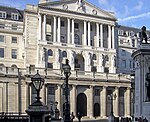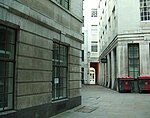London Troops War Memorial
1920 establishments in the United Kingdom1920 sculpturesBronze sculptures in the United KingdomGrade II* listed buildings in the City of LondonGrade II* listed monuments and memorials ... and 5 more
Military memorials in LondonOutdoor sculptures in LondonStatues in LondonWorld War II memorials in EnglandWorld War I memorials in England

The London Troops War Memorial, located in front of the Royal Exchange in the City of London, commemorates the men of London who fought in World War I and World War II.
Excerpt from the Wikipedia article London Troops War Memorial (License: CC BY-SA 3.0, Authors, Images).London Troops War Memorial
Cornhill, City of London
Geographical coordinates (GPS) Address External links Nearby Places Show on map
Geographical coordinates (GPS)
| Latitude | Longitude |
|---|---|
| N 51.513508 ° | E -0.088057 ° |
Address
London Troops War Memorial
Cornhill
EC3V 3NR City of London
England, United Kingdom
Open on Google Maps











